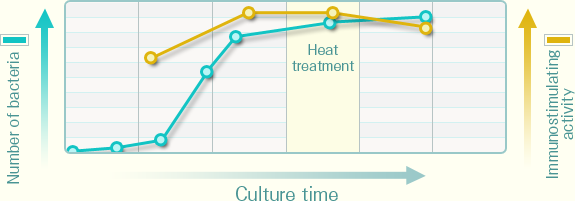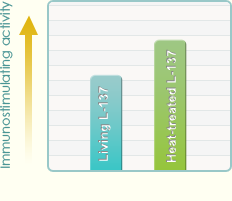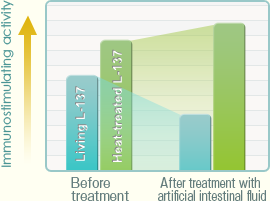

Heat-treated lactic acid bacteria cannot grow in our intestine.
However, there is a reason why we perform heat treatment.
Heat treatment convert the lactic acid bacterium L-137 to the stronger and more stable HK L-137.
Since the lactic acid bacteria are living organisms, various factors affect their features. For example, the immunostimulating activity gradually increases, reaches the peak, and then decreases during their growth. This means that immunostimulating activity of living lactic acid bacteria will change during processing and storage, even if the bacteria are collected when their activity reaches the peak. Their activity may occasionally decrease to a great extent depending on the conditions of processing and storage. Under these circumstances, it is impossible to provide living lactic acid bacteria with stable immunostimulating activity.
To solve this problem, we heat-treat L-137 when its activity is high, resulting in generation of HK L-137 with stable immunostimulating activity.

L-137 grows rapidly at the initial period, and grows gradually thereafter while the immunostimulating activity (IL-12 inducing activity) gradually decreases.
Biosci Biotechnol Biochem 76: 918-922 (2012)
By heat treatment, the immunostimulating activity of the lactic acid bacteria can be kept at a high level until their ingestion. If you want to increase the number of lactic acid bacteria, you had better culture the bacteria for a longer period. However, in case of L-137, we stop its culture before reaching the maximal growth and heat-treat L-137 to stabilize its immunostimulating activity.
There are two other reasons for heat treatment. One reason is that the immunostimulating activity of L-137 actually increases with heat treatment (left figure below).
There is another reason for heat treatment.
Most living lactic acid bacteria die in the gastric acid. The immunostimulating activity of living bacteria decreases in digestive fluids. However, the immunostimulating activity of L-137, which has been heat-treated at the right timing, is not influenced by gastric acid and intestinal digestive fluid (right figure below).
The immunostimulating activity of living or heat-treated L-137 was examined by using spleen cells.

The immunostimulating activity of heattreated L-137 (HK-L137) is higher compared to that of living L-137.
The immunostimulating activity of living or heat-treated L-137 after treatment with artificial intestinal fluid(pancreatic fluid) was examined using spleen cells.

The immunostimulating activity of living L-137 decreased after treatment with artificial intestinal fluid.
Biosci Biotechnol Biochem 76: 918-922 (2012)
As shown above, heat treatment has the two advantages of “increasing the immunostimulating activity” and “stabilizing the immunostimulating activity.” So we can offer HK L-137 with high and stable immunostimulating activity which can act effectively in the body.
In order to stimulate the immunity, HK L-137 has to contact with immune cells. Orally taken HK L-137 will encounter the immune cells in the intestine.
The intestine, where the nutrients from food are absorbed, is the first defense line against foreign substances. This is why the intestine contains many immune cells and constitutes the largest immune organ. The small intestine has special immune tissues that constantly monitor the presence of foreign substances existing in the digested foods. It is considered that HK L-137 encounters immune cells in these tissues and stimulates them, leading to augmentation of systemic immunity.
This is why HK L-137 has to keep its immunostimulating activity in the intestine.